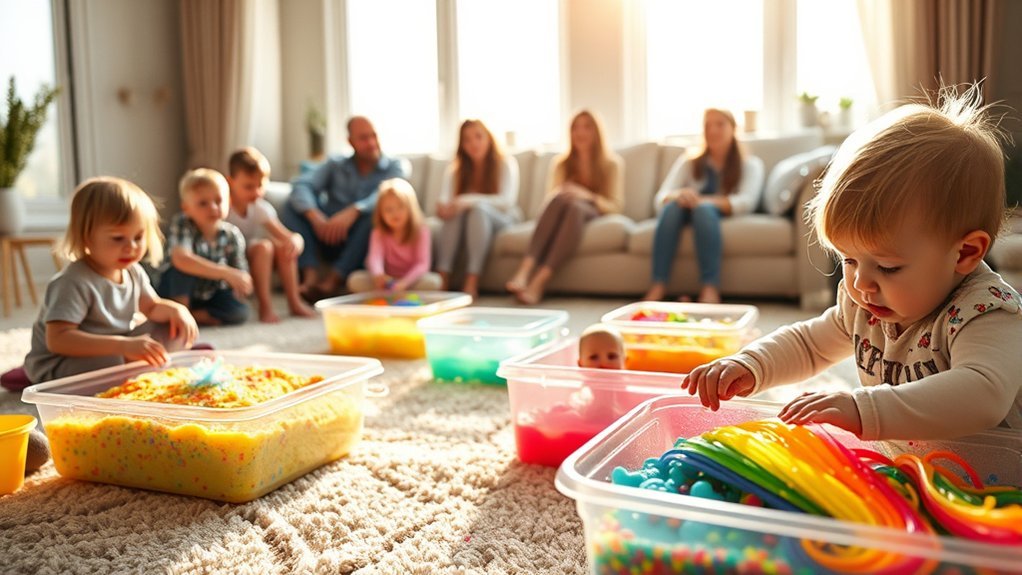Did you know that sensory play can greatly enhance your child’s cognitive and emotional development? By engaging in hands-on activities, you not only stimulate their senses but also promote essential skills like problem-solving and social interaction. As you explore various sensory play ideas, you’ll discover how these experiences can be seamlessly integrated into your daily routines. What are some practical ways to start incorporating these enriching activities into your family’s life?
The Importance of Sensory Play in Early Childhood Development
Although you mightn’t realize it, sensory play is crucial for your child’s early development. Engaging in activities that stimulate the senses—sight, sound, touch, taste, and smell—helps your child build critical cognitive and motor skills.
Research shows that sensory experiences promote brain development by creating neural connections and enhancing problem-solving abilities. When your child interacts with different textures, colors, and sounds, they’re not just playing; they’re exploring the world around them.
This exploration fosters creativity and encourages curiosity, essential traits for lifelong learning. Additionally, sensory play can aid emotional regulation, helping your child express feelings and develop social skills.
Engaging Sensory Play Activities to Try at Home
Here are five engaging sensory play activities you can try at home to spark your child’s curiosity and creativity:
- DIY Sensory Bins: Fill a bin with rice, beans, or sand, and add small toys or scooping tools for exploration.
- Nature Walk Treasure Hunt: Collect leaves, rocks, and flowers on a walk, then create a sensory collage with your finds.
- Homemade Playdough: Make playdough using flour, water, and salt. Add food coloring or scents like vanilla for extra sensory stimulation.
These activities not only entertain but also enhance fine motor skills and encourage imaginative play.
By incorporating sensory experiences, you’re helping your child learn through exploration, making their playtime both fun and educational.
Get creative, and watch their excitement grow!
How Sensory Play Supports Different Learning Styles
As you explore sensory play with your child, you’ll discover how it supports various learning styles, making it a powerful tool for development.
For visual learners, colorful materials and textures captivate attention, enhancing observation skills. Auditory learners benefit from the sounds of play, like pouring sand or splashing water, which reinforces listening and communication. Kinesthetic learners thrive on hands-on activities that promote fine motor skills and physical coordination.
Additionally, sensory play fosters social interaction, allowing children to collaborate and share experiences, which benefits interpersonal learners. By engaging multiple senses, sensory play not only accommodates different learning preferences but also encourages creativity and problem-solving.
You’ll find that this versatile approach can create a rich learning environment tailored to your child’s unique style.
Tips for Incorporating Sensory Play Into Daily Routines
Incorporating sensory play into your daily routine can be both simple and rewarding, transforming everyday activities into engaging learning experiences. Here are some tips to get started:
Incorporating sensory play into daily routines enriches learning and transforms ordinary moments into engaging experiences.
- Incorporate Textures: Use different fabrics during storytime or art projects. Let your child feel various textures to enhance their tactile exploration.
- Cooking Together: Involve your child in meal prep. Have them touch, smell, and taste ingredients, encouraging sensory engagement while learning about healthy foods.
- Nature Walks: Take a stroll outside and encourage your child to explore nature. Collect leaves, stones, or flowers, and discuss their shapes, colors, and textures.
These activities not only stimulate your child’s senses but also foster creativity, problem-solving, and communication skills, making learning a fun part of your day.
Safety Considerations for Sensory Play Activities
While sensory play offers countless benefits for children, guaranteeing their safety during these activities is vital.
Start by selecting age-appropriate materials; avoid items that pose choking hazards. Supervision is imperative, so keep a close eye on your child as they explore.
When using liquids or messy substances, protect your work area with covers or mats to prevent slips and spills. Always choose non-toxic, hypoallergenic materials to reduce the risk of skin irritation or allergies.
If your child has specific sensitivities, customize the sensory experience accordingly.
Finally, regularly clean and inspect sensory play items to make certain they remain safe and hygienic.
Frequently Asked Questions
How Much Time Should My Child Spend on Sensory Play?
Your child should engage in sensory play for about 30 minutes to an hour daily. This balance allows exploration and creativity while preventing overstimulation, fostering essential skills like problem-solving, communication, and emotional regulation effectively.
Can Sensory Play Be Beneficial for Older Children?
Sensory play benefits older children by enhancing their cognitive skills, promoting creativity, and improving focus. It encourages problem-solving and helps them process emotions, making it a valuable activity at any age.
What Materials Are Best for Sensory Play at Home?
You can use materials like kinetic sand, water beads, rice, and playdough for sensory play at home. These items stimulate touch and creativity, providing an engaging experience that supports fine motor skills and imaginative play.
Are There Sensory Play Options for Children With Disabilities?
Absolutely, there are numerous sensory play options for children with disabilities. Adapt activities using textured materials, auditory toys, or visual aids. Tailoring experiences to their unique needs enhances engagement and promotes skill development effectively.
How Can I Encourage My Child to Engage in Sensory Play?
You might think sensory play’s too messy, but it’s worth it! Start with simple activities like finger painting or sand play, and let your child explore textures. They’ll have fun while developing essential skills!
Conclusion
Incorporating sensory play into your child’s routine is like giving them a treasure map to their own development. It enriches their learning, boosts creativity, and strengthens your bond through shared experiences. As you navigate these activities, remember that every moment spent exploring can spark curiosity and joy, akin to the way children once discovered the world without screens. So immerse yourself, get messy, and watch your little one thrive as they engage their senses and grow in countless ways.
